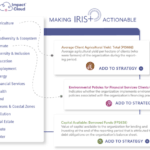Embedding Gender Equity Into Companies’ DNA: An Investor Consortium Builds the Evidence Base for Gender Lens Investing
Gender lens investing is moving gradually into the mainstream. But both investors and enterprises still need support in getting buy-in for this approach – and in implementing it effectively – among both their leadership and staff. To that end, the Gender-Smart Enterprise Assistance Research Coalition (G-SEARCh) is working to “embed gender equity in the DNA of companies.” Comprising a group of six like-minded impact investors – AlphaMundi Foundation, Acumen, SEAF, Root Capital, AHL Venture Partners and Shell Foundation – the consortium is helping to build the evidence base for investing with a gender lens, and to scale this approach across sectors.
As part of this effort, the Performance Measurement and Improvement team at the William Davidson Institute (NextBillion’s parent organization) is generating evidence on how gender lens investments impact the financial and social performance of small and medium enterprises (SMEs) in emerging markets. NextBillion spoke with Lisa Willems, managing director at AlphaMundi, and Rebecca Fries, CEO and founding director of Value for Women (a specialized advisory firm that’s also a G-SEARCh partner), about the momentum that’s driving gender lens investing, the challenges it faces and the work the new consortium is doing.
James Militzer: Could you share the motivation behind the forming of this consortium? Why did these six investors come together and what do you aim to achieve?

Lisa Willems, managing director at AlphaMundi
Lisa Willems: As AlphaMundi started to refine our strategy as a gender lens investor, we piloted customized and targeted business-first, gender-smart technical assistance activities with our portfolio companies (SMEs in emerging markets). We began to recognize that other impact investors were taking a similar approach, with a similar goal in mind. We were also interested in building an evidence base for this type of work, and we saw an opportunity to coordinate and collaborate with peer investors to broaden the research base and share consolidated learnings with the gender lens investing community.
Specifically, we saw an opportunity to:
- Outline the methodology, tools and frameworks used by a broader set of impact investors subsidizing gender-smart technical assistance interventions with portfolio companies;
- Evaluate the efficacy and cost-effectiveness of this approach; and
- Document the process to secure buy-in from SME leadership teams and staff.
James Militzer: Can you point to any key statistics that highlight the value of a gender lens investing approach – either in terms of the impact it can make on women (and their communities), or the existing inequities in the current allocation of investment capital?
Lisa Willems: SMEs are recognized as a key driver for economic growth. However, women-owned enterprises only account for approximately 31-38% of all SMEs in emerging markets, and the average growth rate of women-owned enterprises is significantly lower than that of men-owned businesses. This is due to factors that include institutional and regulatory issues, women’s lack of access to finance and/or collateral, their relatively low rates of business education or formal work experience, the disproportionate burden of household management responsibilities, and the general confinement of women’s businesses to slower-growth sectors.
Given the relatively low rates of investible female-owned SMEs in emerging markets, impact investors are working with SMEs, regardless of ownership, leadership or product/service orientation, to incorporate gender across their business. Study after study has shown that investing in women living in low- and middle-income countries has a strong ripple effect. When women earn more money they invest their economic gains into their children’s education and health, and also into their local economies.

Rebecca Fries, CEO and founding director of Value for Women
Rebecca Fries: This role of SMEs as engines of business and social impact is one reason we’re keen to partner with investors such as AlphaMundi to help these enterprises thrive. Gender lens investors just beginning their journeys can consider investing in women-led SMEs, in companies that offer products and services with a disproportionate impact on women, and in companies that prioritize gender inclusivity in the workforce. These strategies bring opportunities to simultaneously increase gender equality and improve business outcomes:
- Investing in women-led SMEs: Only 7% of venture capital/private equity in emerging markets goes to women-led businesses, meaning there is a large untapped investment opportunity for investors who go beyond traditional deal-sourcing channels. Investors can adjust their deal-sourcing strategies and/or review their investment decision-making to increase the number of women-led businesses they support.
- Investing in SMEs offering products and services for women or that disrupt gender roles: For example, the global femtech market is expected to grow from US $25 billion in 2019 to US $50 billion by 2025. Femtech companies improve women’s health by targeting health issues such as maternal mortality or access to reproductive health services.
- Investing in SMEs with a gender-inclusive workforce: A study by Sodexo showed that gender-diverse teams (defined as having a male-female ratio between 40-60%) achieve better results, including: improved employee engagement, improved employee retention, improved client retention, increased safety in the workplace and increased operating margins. And Calvert Impact Capital found that companies with the highest percentages of women in leadership positions had 18.1% return on sales, 3.9% return on assets and 8.6% return on equity (compared to -1.09%, 0.3% and 4.4% respectively), relative to companies with fewer women in leadership positions.
While many investors are convinced that investing with a gender lens is important, they need ideas for the “how.” Value for Women’s “How to Invest with a Gender Lens: A Guide for Investors in Emerging Markets” explores these and other entry points.
James Militzer: What concerns do other investors raise about adopting a gender lens strategy – is there any downside for investors that needs to be addressed? What would be your “elevator pitch” to an investor who hasn’t bought into the value of this approach?
Lisa Willems: We think there is a lot of interest in adopting this strategy, but many investors don’t know where to start. The journey to gender lens investing also requires investors to dedicate time to it, looking first internally at their operations to understand their priorities and unconscious biases, and then learning how they can support their portfolio companies.
Other challenges/downsides can include:
- Implementing gender-inclusive strategies requires subsidy, both at the fund manager and SME levels.
- Overcoming pre-existing perceptions and biases around what gender lens investing means.
My elevator pitch would be: “Embedding gender equity practices across your business operations, especially at the governance and senior management level, can enhance both social and financial returns, empowering women across all levels of the organization.”
Rebecca Fries: Other challenges can involve:
- Investors’ concerns about making tradeoffs – i.e., the belief that applying a gender lens limits them, rather than expands their opportunities. We see gender as a lens, not a limitation – and as a way to deliver outsized impact.
- Investors’ worries about being pigeonholed – i.e., the concern that if they call themselves a gender lens investor, some asset owners won’t identify themselves with that approach and will write off the fund. In reality, most of the investors we work with build a gender strategy that fits with their broader mission and strategy, and that helps them position themselves on gender in a way that aligns with their investment goals.
- Investors’ belief that it is difficult to get started: Investors think that gender lens investing equates to one specific thing, such as investing in women-led businesses or developing good HR policies. In reality, there are many entry points and many ways to adopt gender inclusive practices. More investors and businesses will benefit when, as an industry, we reduce the barrier to entry while also incentivizing all players to ask what more they can do. In other words, if you are investing in women-led businesses, can you also think about a strategy to support your portfolio companies to become more gender inclusive?
As for an “elevator pitch,” I’d say that gender lens investing is a surefire approach for getting the most impact for your investment dollar.
James Militzer: What are some of the most important questions that investors and entrepreneurs should ask when they begin their gender lens investing journey? Are there any common pitfalls that they should be aware of?
Lisa Willems: The most important questions for investors include:
- Have you taken a look in the mirror as an investor? How gender-balanced is your investment team? How diverse is your investment committee or board? Who has a “seat at the table” throughout the investment life cycle?
- What is your strategy? How can you wield your influence as a capital provider to promote gender equity as a core business principle, akin to ESG, with your investees?
Rebecca Fries: Some additional questions include:
- What does gender lens investing mean to you: What are your priorities, and how does gender lens investing align with your investment thesis?
- Why do you want to have impact: What’s your motivation and rationale? What are the social and business objectives behind your gender equality work?
- What impact do you want to have: What is the gender goal you might have or the problem you want to help solve?
- What kind of capital do you have, and how can you leverage this capital (and the services alongside it) to effect change? For instance, an equity investor may have a greater capacity for influence, but an investor that offers business development services or raises philanthropic capital to support businesses may be able to support businesses on gender more effectively.
Lisa Willems and Rebecca Fries: The main questions for SMEs are similar to the investor questions above:
- What are your company’s gender equality goals? How do these tie into your business goals?
- What impact do you want to have, and with what stakeholders? What are the problems that you want to help solve? To identify these problems, SMEs may start with a simple gender analysis – e.g.: looking at where the women are and aren’t throughout the supply chain and examining the reasons for these disparities.
- How much time and resources are you willing to commit to trying out new activities? What support services and resources are available?
Common pitfalls (for investors and SMEs alike) include:
- Making “the perfect the enemy of the good.” It is important to just start somewhere.
- Becoming so overwhelmed that you don’t know where/how to start.
To avoid these obstacles, it’s important to allocate some time and resources and jump in. You can learn along the way, as well as seek mentor/peer organizations who have already started their journey.
James Militzer: The success of gender lens investing will depend on both investors like AlphaMundi, and intermediaries like Value for Women: What competencies does each group need to bring to the table to make this investing approach effective? How can these two groups of stakeholders maximize the impact of their collaborations?
Lisa Willems: At the fund level, adopting a gender lens approach requires buy-in from all stakeholders – from the investment management team to the investment committee, and ultimately the fund’s board of directors. Once this is achieved, a process needs to be put in place to work with companies during the due diligence process, and to train the investment staff to ask gender-sensitive questions and apply a gender lens to the entire diligence and monitoring approach. Integrating gender into the due diligence phase also supports the introduction of these concepts to the SME, which helps with buy-in later in the process. The ultimate success of these interventions is also predicated on the trust between the two organizations, and the competency of both parties to scope and then implement the intervention.
We also see tremendous value in learning from our peers and partners, and sharing lessons learned from our experience as a gender lens investor. This was one of the key motivators in founding G-SEARCh.
Rebecca Fries: To make this approach effective, investors would ideally have the following orientations:
- An open mind: This includes the willingness to explore different possibilities and models, and also to look critically at current ways of doing business, and to reexamine them with a gender lens.
- Patience and flexibility: There is no silver bullet, and gender is nuanced. That said, there are easy entry points. Long-term efforts can pay real dividends in the form of social impacts and business returns, both for the investor and the companies. It’s impossible for an institution to become a gender lens investor overnight: It takes time and self-examination, deepening over time, as well as iteration and learning.
- Collaboration: It’s helpful for investors to learn from other institutions and to actively participate in spaces (such as G-SEARCh, ANDE, the Gender-Smart Summit and others) to trade ideas and learnings, and evolve in their gender lens investing practices.
Intermediaries would ideally have the following orientations:
- The willingness to listen to and understand the business priorities of the investor and the SMEs: There is no one-size-fits all approach, so the ways an investor or company implements gender lens work will vary significantly. The intermediary needs to tailor and customize their approach to maximize the chances of impact and sustainability for the players involved.
- Knowledge of the business and investing realms.
- Active participation in gender lens investing spaces, to glean new insights and practices.
James Militzer: The ultimate impact of gender lens investing will also depend on the active participation of investees. How does G-SEARCH work to “embed gender equity in the DNA of companies,” as the consortium’s website puts it?
Lisa Willems: Our hypothesis is that working with social enterprises in emerging economies to integrate gender insights—regardless of their starting place—at an early stage is one of the most effective ways to enhance social and financial performance. If SME founders learn the value of applying a gender lens to their operations at an early stage, they will integrate gender equity throughout their operations, empowering women at all levels of the organization as it grows. Due to resource constraints and competing priorities for nascent companies, grant capital is often required to implement analysis, workshops and trainings to sensitize and integrate gender considerations across their business.
We view the decision to support gender-smart technical assistance as part of the gender lens investing journey for investees, as this goes beyond the provision of capital to female founders and companies providing products/services to women and girls. AlphaMundi (and members of G-SEARCh) aim to influence all SMEs to become long-term champions of gender equity, and ultimately empower the next generation of female entrepreneurs.
Rebecca Fries: Value for Women’s approach to working with investors includes helping companies to develop “gender forward business practices” that respond to business priorities. Alignment with business priorities ensures that this is compelling to company leadership in the long term. We often say “gender-smart,” because the activities both equate to better performance as well as improved gender equality (vis-a-vis a company’s employees, suppliers, distributors, customers, etc.). The solutions we design are highly customized based on the specific business needs and their context, using a gender and business diagnostic tool and a participatory co-design phase along with each SME. By going through this process and actually implementing these activities with support from Value for Women, companies become more comfortable applying a gender lens, and recognize the impact and business value of thinking about gender diversity across their business functions.
James Militzer: Preview the latest report that G-SEARCH has just released, in collaboration with the William Davidson Institute at the University of Michigan (WDI), in time for the Gender Smart Investing Summit. What knowledge gaps does this report fill in the impact investing community? And what’s upcoming from the group?
Lisa Willems and Rebecca Fries: The latest report covers the approaches and tools used to design and implement gender-smart technical assistance provided to portfolio companies. Business-first, gender-smart technical assistance falls under the umbrella of gender lens investing, and is now picking up momentum. The report also covers the human and technical resources necessary for this kind of work, and how roles and responsibilities are divided among the investor, implementing partner (if applicable), and company leadership and staff. It also captures our collective experiences and lessons for peer investors and entrepreneurs looking to begin gender-inclusive work that creates value for all stakeholders.
Over this year, our research partner, WDI, will continue to measure the effectiveness of the various gender-smart technical assistance activities conducted with over 30 participating companies across geographies and sectors. The consortium and WDI will also implement case study research to measure the social outcomes from the activities focused on women stakeholders of five companies. All of these findings will be made public through reports, interactive multimedia, and a toolkit that will share our surveys, tools and interview protocols.
James Militzer: Looking 10 years into the future, what’s the best-case scenario for the adoption and development of gender lens investing, and what is the worst-case scenario?
Lisa Willems and Rebecca Fries: The best-case scenario is that gender lens investing just becomes good investing, as mainstream investors become keen to invest with a gender lens, recognizing that the evidence base is robust and well-established in diverse sectors and contexts, and there is strong evidence of the socio-economic impact generated among stakeholders. So there is no longer a need to “build the business case” for this type of work, and gender equity becomes a core business principle, akin to ESG, as gender equity is built into policies and integrated across all investing practices. Additionally, we’d see more women in c-level positions, and more female founders in emerging markets driving impact and inclusion.
The worst-case scenario would happen if gender lens investing becomes mainstream without a tie to measurable social outcomes: It’s key that gender lens investing remains centered on simultaneously driving financial and social returns.
James Militzer is the managing editor of NextBillion.
Photo courtesy of Sistema.bio.
- Categories
- Investing




